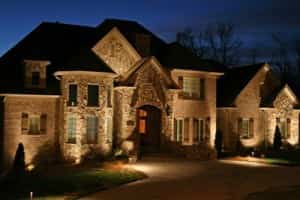Even though you and your family are inside your home, there are plenty of reasons to add lighting to the exterior. Outdoor lighting can be used to improve the appearance of your house at night, deter crime and increase overall safety. The best aspect of outdoor lighting is that you can easily install it yourself.
Where Do You Place Outdoor Accent Lights?
There are many different areas where you can install outdoor lights, depending upon your preferences and goals for the lighting system. If your goal is to increase safety, you will likely want to illuminate any walkways, steps, and entryways. This will make it easier to approach the house at night and will make it possible to see visitors.
Some homeowners choose to use accent lights to make design elements of the house and landscape visible at night. In addition to lighting walkways, you might also highlight interesting aspects of the architecture or plants around your home. It is not unusual to add outdoor lighting around a flowerbed, garden, or gazebo in order to add an outdoor ambiance.
No Need to Be or Hire a Master Electrician
The true beauty of an outdoor lighting system is that it is extremely simple to install, even if you are not an electrician. As This Old House explains, all you need in order to get started is a transformer, a low-voltage electrical cable, and any light fixtures that you would like to use.
When choosing lights, it is important to remember that you need bulbs with very low wattage. As these lights will be used outdoors, at night, it is very easy for the light to become too harsh. A little voltage will go a long way.
The transformer that you use will only need to have enough capacity to support all of the lights that you have chosen to use as your outdoor lights. It will be plugged into an outdoor electrical outlet that is GFCI-protected and fitted with a cover.

The low-voltage cable will then be used to connect your light fixtures to the transformer. For most fixtures, a 3-inch trench will suffice when concealing the cable along your walkways and other lighted areas.
Things to Keep in Mind When Choosing and Installing Your Exterior Lights
Aim and Shield Your Lights – It is very easy for outdoor lighting to go from helpful and pleasant to intrusive. To avoid having a light that shines too brightly into your home or your neighbors’ homes, aim them carefully and use fixtures that have shields. As Better Homes and Gardens describes, this will allow you to concentrate the light exactly where you want it, reducing light pollution.
Reducing Your Energy Costs
Obviously, the lower wattage bulbs will enable you to run an energy-efficient exterior lighting system. However, in some regions with sunny climates, it might also be possible for you to power your lighting system using solar energy. Instead of using your home’s energy system to power your lights, you can create a separate system that is powered entirely by solar panels.
Another Great Resource From Phoebe Parlade
Have you considered redecorating or renovating your home lately? Maybe you like how it is, but believe it could be lit better. LED lights are fast becoming the go-to light bulbs for modern homes because of their energy efficiency, durability, and clarity.
This guide takes you through each area of your home including standard rooms, loft conversions, garages, workshops, and sheds. Providing detailed information on each one.
You will also find a step-by-step guide for installing each type of light bulb including downlights, spotlights, tube lights, floodlights, high bays, and bulkheads.
Finally, the guide covers all aspects of DIY lighting and includes a wide range of health and safety considerations including preparation, the impact on your household, clothes, safety equipment, and asbestos awareness. It also covers essential advice on when to seek professional help. Some jobs are doable by anyone, but when complex wiring is involved, it’s best to seek a professional electrician to wire your lights.
To learn more about how to complete a DIY LED project in your home.
